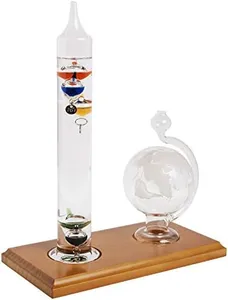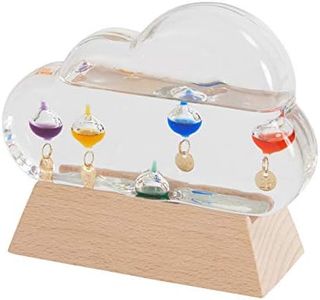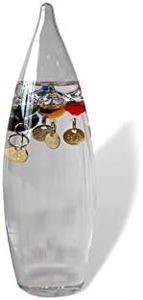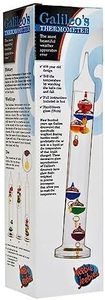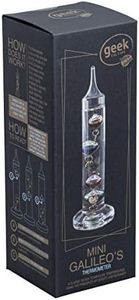We Use CookiesWe use cookies to enhance the security, performance,
functionality and for analytical and promotional activities. By continuing to browse this site you
are agreeing to our privacy policy
10 Best Galileo Thermometers
From leading brands and best sellers available on the web.Buying Guide for the Best Galileo Thermometers
Galileo thermometers are fascinating devices that not only measure temperature but also act as unique decorative pieces. They work using the principle of buoyancy, where glass bulbs filled with liquid in a sealed cylinder rise or fall depending on the surrounding temperature. When choosing a Galileo thermometer, it's important to understand how these work and what features or specifications will influence your experience with them. Your choice should reflect your preference for visibility, practicality, and overall aesthetics.Size (Height and Diameter)The size of a Galileo thermometer, typically measured by its height and width (diameter), impacts how easily you can read it and where you can display it. Smaller thermometers are more portable and fit well on crowded shelves, while taller ones often have more bulbs and are easier to read from a distance. If you want the thermometer to be a striking decorative piece or easier to read, a larger size is suitable. For subtle, space-saving options, a smaller size is best.
Temperature RangeThis specification refers to the span of temperatures the thermometer can measure, usually marked on the hanging tags inside. Common ranges are about 18°C to 28°C (64°F to 82°F). A broader range is helpful if your room temperature often goes above or below average, while a narrower range can give more precise readings within a comfortable indoor climate. Consider your typical room temperatures and choose a thermometer whose range covers them for the best accuracy.
Number of BulbsEach floating bulb represents a specific temperature, and more bulbs mean more detailed readings. Thermometers with fewer bulbs give you a general idea of the temperature, while those with more bulbs offer more precise readings, sometimes down to every 2°C or less. If you're interested in fine details or scientific curiosity, pick a thermometer with many bulbs. If you just want a decorative look or a quick temperature check, fewer bulbs will suffice.
Readability of TagsThe metallic tags attached to each bulb state the temperature. The size, color, and clarity of these tags affect how easy it is to read the temperature. Clear, large, and contrasting tags are best if you plan to actually use the thermometer to check the temperature. If the look is more important than function, tag readability can be less of a concern.
Construction QualitySince Galileo thermometers are often displayed, their build quality—including the glass thickness and how well the ends are sealed—is important for durability and safety. Higher quality build means lower risk of leaks or breakage, especially if the thermometer could be knocked over. If it's for a high-traffic area, prioritize solid construction; for display in safe spots, standard quality should be fine.
Liquid and Color AestheticsThe appearance of the thermometer is influenced by the color of the floating bulbs and the liquid inside. Some have clear liquids and brightly colored bulbs, while others are more subtle. This is mainly a style choice: select colors that match your decor or that you find pleasing, as it won't affect functionality.
